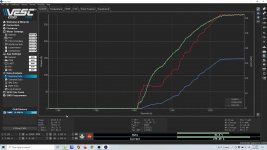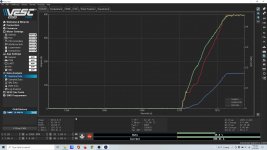Wow... even $170 shipping is crazy.
I had a question, so I wrote this stuff below. Going through the process of writing it, I figured it out. Rather than just delete it, I figured I'd post it anyway, since it might help someone understand this stuff better (or make it more confusing, but hey - it's data and analysis; that's always useful):
"Going back to the duty cycle thing; the one thing that I'm still not really understanding completely is that duty cycle and KV don't really correlate. What I mean by that is that in my case, my actual RPM doesn't match my expected RPM based on duty cycle and KV.
Going back to the VESC log:

This one is with the restrictor in place. Battery voltage is 56.3. Duty cycle is 62.4%. eRPM is 70,931. If we divide eRPM by the number of pole pairs (3), we get 23,644 motor rpm. If we multiply battery voltage times duty cycle, we get 35.13 volts. My motor's kV is 750. If we multiply kV by actual voltage based on duty cycle, we get 26,347.5 calculated motor rpm, for a difference of 2,703.5 rpm less.
Now let's apply the same math to the unrestricted datalog (where the restrictor was removed and the load increased dramatically):

Here we're seeing an actual motor RPM of 14,413. But based on the duty cycle/voltage, we should be seeing 19,347 motor rpm; for a difference of 4,934 rpm less.
I realize that kV represents unloaded speed, and we've seen a much larger drop going from less load (restrictor plate) to more load (no restrictor plate); both numerically and a much larger drop proportionally (~10% vs ~26%). That makes sense.
Duty cycle should correlate directly with actual rpm, shouldn't it?
But looking at the two graphs, only kinda-sorta. Looking at it from a "per-percent duty cycle" vs RPM, the heavier loaded graph is lower by about 20%... oh, nevermind; I get it now..."
So what I've realized at this point is kV isn't a fixed number and I wasn't taking that into consideration. Unloaded kV is one thing (and what you see when you're buying your motor); lightly loaded kV is a bit lower, and heavily loaded kV is lower still.
Let's look at these graphs and put some kV numbers to them.
The motor's advertised kV: 750
The motor's lightly loaded kV: 673
The motor's heavily loaded kV: 559
On one hand, this seems obvious. On the other hand, we now have actual numbers to put to the theory, and it also explains a lot. So if I go with a step-down ratio on the motor, rather than a step-up ratio, that should lessen the load on the motor as well as allow for much more RPM and a higher duty cycle. At least that's the current theory and why I think cmoalem was right and I was wrong. Also, keep in mind that I'm over-currenting the motor by a good bit. The motor's rated for 283 amps; we're pushing 400 amps in both tests. One thing I don't know is if that 283 amp rating is an absolute number, or an average. In other words, if we're pushing 400 amp pulses through the motor at a 50% duty cycle, does that mean (from a manufacturer's rated current perspective), we're pushing 400 amps or 200 amps?
So now it's finding the optimum balance; which we can get somewhat close to with bench-testing, but until it's on the car, we won't be able to find the optimum balance for that particular engine. That's why I ordered 16, 14 and 12 tooth pulleys, and a 255, 260, 270mm belt. Watch - with my luck, I'll need an 18 tooth pulley, and optimum will be 1:1 - where we started with version 1... that would be my luck.


